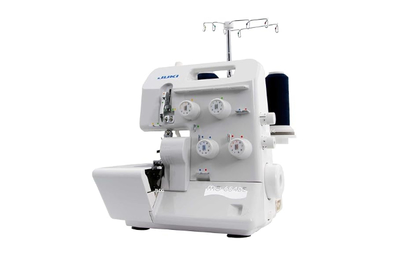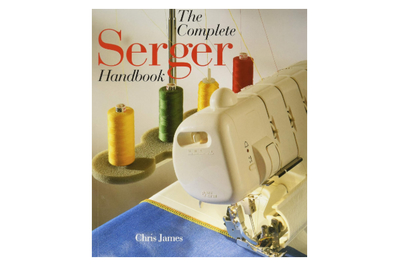
A person can spend a lot of money on a serger—up to thousands of dollars on models with air threading, which simplifies the threading process by sucking the threads through little vacuums and guiding them along their paths. My model, the Juki MO-654DE—which I purchased used on Facebook Marketplace from a fashion student—ran me $280 in late 2020.
I did a lot of searching—of the Google, Reddit, and soul varieties. And I settled on this model because it had been well reviewed for years, and it was ubiquitous enough that I could find how-tos specifically about this machine. Also, if it was good enough for a pattern designer whose work I loved, I figured it was good enough for me.
If you buy the same machine new, you can expect to pay $400-ish. You might, like me, get lucky and find someone offloading theirs for much less on a site like Marketplace or Craigslist.
After I took the machine to my favorite local repair shop for a cleaning and servicing, and it got a clean bill of health, I dove into the manual and YouTube tutorials to learn how to thread it. It turns out that it’s really easy once you’ve done it a few times—there are colored labels to mark the path of each individual thread, and a little trial and error has rarely killed somebody. Plus, if you have any questions, chances are good that someone on the internet has already asked it. Searching “serger not sewing why” or “serger unthreading how help” will yield answers.
I also found Chris James’s The Complete Serger Handbook to be extremely helpful in explaining what each of the threads is doing in the stitch, as well as in showing which settings to tweak, and how, for different fabrics and effects. The book has detailed photos and diagrams that show not only what a seam should look like but also examples of what it shouldn’t look like, plus what is happening to make it look like that and how to adjust and correct it.
In no time at all, I became, at the very least, a serger enthusiast, if not a serger pro. Since that initial servicing, I haven’t had to make any sick visits with my serger. I snapped a needle once when I flew too close to the sun while finishing a seam near a zipper, but putting in a new one was easy. I keep a tiny vacuum cleaner in my desk drawer to clean fuzz out of the casing when it accumulates, too.
Although some sewists swear by rethreading their sergers by knotting the new thread to the old and sliding it through, that can damage the machine’s tension disks. With a pair of long-nosed tweezers, a little pair of scissors to snip off the end of the thread for a clean tip, and just a bit of patience, changing out threads is only a minor inconvenience.
Or, if you’re not fussy, just do what I do: Load the machine once with a fun gradient thread, and decide that that’s your “signature color” until the cones run empty, no matter what color your fabric is. It’s like grandma always said: Whimsy is king, and matching is for schmoes.
This article was edited by Ben Keough and Erica Ogg.






